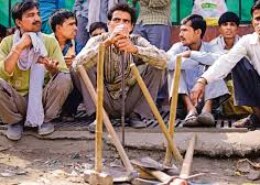The Nehruvian model and the economic reforms of 1991 represent two distinct approaches to India's economic development. Here's a breakdown of their key differences: Nehruvian Model (Pre-1991): Focus: Import substitution industrialization (ISI) - building domestic industries to reduce reliance on impRead more
The Nehruvian model and the economic reforms of 1991 represent two distinct approaches to India’s economic development. Here’s a breakdown of their key differences:
Nehruvian Model (Pre-1991):
- Focus: Import substitution industrialization (ISI) – building domestic industries to reduce reliance on imports.
- Role of Government: Strong state intervention through Five-Year Plans, directing investment into heavy industries like steel, coal, and power.
- Trade: Protectionist policies with high tariffs on foreign goods to shield domestic industries.
- Public vs. Private Sector: Dominant role for Public Sector Undertakings (PSUs) with limited private sector participation.
Economic Reforms (1991 onwards):
- Focus: Liberalization, Privatization, Globalization (LPG).
- Role of Government: Reduced government control, allowing market forces to play a bigger role.
- Trade: Lowering tariffs and promoting exports to integrate with the global economy.
- Public vs. Private Sector: Increased role for the private sector, with disinvestment of PSUs in some areas.
Here’s a table summarizing the key differences:
| Feature | Nehruvian Model | Economic Reforms (1991 onwards) |
|---|---|---|
| Focus | Import substitution industrialization | Liberalization, Privatization, Globalization |
| Role of Government | Strong state intervention | Reduced government control |
| Trade | Protectionist policies | Lower tariffs, promoting exports |
| Public vs. Private Sector | Dominant role for PSUs | Increased role for private sector |
The reforms aimed to address the limitations of the Nehruvian model:
- Slow growth: The focus on heavy industries yielded slow economic growth.
- Inefficiencies: PSUs often faced bureaucratic hurdles and inefficiencies.
- Limited competition: Protectionism stifled innovation and competition.
The reforms have had mixed results:
- Faster growth: India’s economy grew at a faster pace after 1991.
- Increased foreign investment: The reforms attracted foreign investment and technology.
- Poverty reduction: Poverty rates have declined significantly.
However, challenges remain:
- Income inequality: The benefits of growth haven’t been evenly distributed.
- Job creation: The shift to a service-oriented economy hasn’t created enough jobs.
- Rural development: The reforms haven’t adequately addressed the needs of the rural sector.
In conclusion, the shift from the Nehruvian model to the 1991 reforms reflects a move towards a more market-oriented economy. While the reforms have led to growth, addressing inequality and rural development remain crucial for India’s economic future.


FERA stands for Foreign Exchange Regulation Act, which was a legislation enacted in India in 1973 to regulate the foreign exchange transactions and investments in the country. The act was passed by the Indian Parliament in 1973 and came into effect on January 1, 1974. Objectives of FERA: The main obRead more
FERA stands for Foreign Exchange Regulation Act, which was a legislation enacted in India in 1973 to regulate the foreign exchange transactions and investments in the country. The act was passed by the Indian Parliament in 1973 and came into effect on January 1, 1974.
Objectives of FERA:
The main objectives of FERA were:
Key provisions of FERA:
Challenges faced by FERA:
FERA was a complex legislation that aimed to regulate foreign exchange transactions and investments in India. While it had its objectives, it faced several challenges, including complexity, bureaucratic hurdles, lack of transparency, and restrictions on trade and investment. Its repeal led to the introduction of FEMA, which has simplified procedures, provided greater flexibility, and harmonized Indian regulations with international standards.
See less